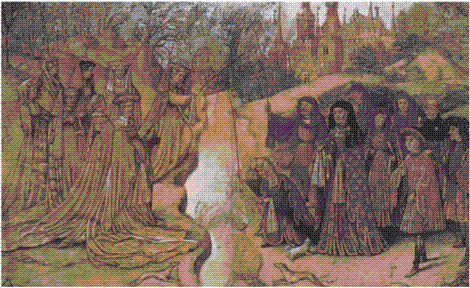Court and Culture
Court and Culture: Dutch literature, 1350-1450, an elegantly produced book, is the translation of Professor Van Oostrom's best known work to date. Het woord van eer. Literatuur aan het Hollandse hof omstreeks 1400 (Amsterdam, 1987) rather burst upon the scene of medieval Dutch studies: the culmination, to date, of a lightning academic career by one of the most dynamic and original personalities of the present generation of medievalists in the Netherlands and Belgium.
F.P. van Oostrom's study was a landmark and an achievement of no small magnitude. It was received both with praise and also with some unease. Scholarly mores in the Netherlands are more Germanic than Anglo-Saxon. ‘Publish and be damned’ is not a statement that translates easily into Dutch. Where elegant, and speculative, synthesizing studies are generally welcomed by Anglo-Saxon scholars, Dutch scholars have a habit of falling upon each tittle and iota for which hard evidence seems to be lacking.
However, Van Oostrom's achievement does not lie only in the fact that this is, in many respects, an Anglo-Saxon rather than a Germanic tour de force. It is a panoramic book which focuses on very particular detail. This, it must be said, is more apparent in the title of the Dutch original than in that of the English translation. Those who expect the literary history of a century may be somewhat disappointed: those who take into account the specification ‘literature at the Dutch court around 1400’ will find a veritable treasure trove.

Cover illustration.
In effect, Van Oostrom constructs his hypotheses with the aid of a relatively small corpus of writings: the moralistic and didactic poetry of the itinerant poet Master William of Hildegaersberch; the courtly lovesongs of the Hague Song Manuscript and the Leiden fragments; chivalric ideology and knowledge as laid down in the chronicles of Bavaria Herald; the learned religious instruction of the ‘summa theologica’ Table of the Christian Faith (Tafel vanden kersten ghelove) by the monk and doctor in theology Dirk van Delft; sophisticated and independent worldly wisdom vis-à-vis love and marriage as embodied in The Course of Love (Der minnen loep), the Flower of Virtue (Blome der doechden) and Mellibeus by the courtier Dirk Potter.
The study of this corpus is flanked by a concise and instructive cultural-historical chapter about the Bavarian Counts who ruled the provinces of Holland, Zeeland and Hainault between 1358 and circa 1417 and a final chapter surveying the significance of that rule for literary culture at the court in The Hague.
This relatively small body of writing produced in a fairly short period for a specific audience presents us nevertheless with the means of addressing a number of surprisingly diverse issues and aspects.
What makes this work so interesting both for the specialist of medieval Dutch literature and culture and for other medievalists, is the constant interaction between the detailed study of a particular situation and the background of concerns which were central to Western European culture. This comes particularly to the fore in the discussion of the work of Bavaria Herald. Chivalry and its values, particularly the concept of honour, were central to the court at The Hague as to many other European courts. Van Oostrom shows how these general values are reflected in the wars waged by the Bavarian Dukes, particularly the campaigns against the Frisians, and the military exploits they thought it necessary, or honourable, to involve themselves in, such as the Prussian campaigns. His discussion of the rise and fall of chivalric values, the way in which Bavaria Herald seems to have outlived what